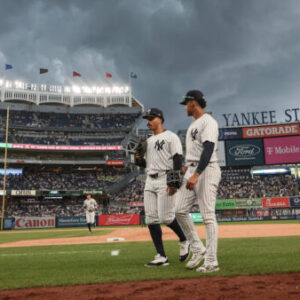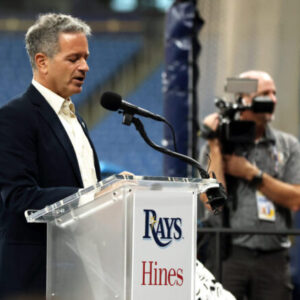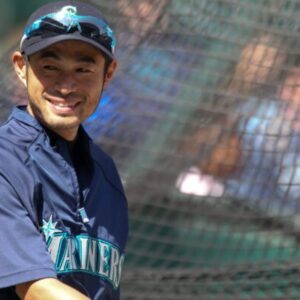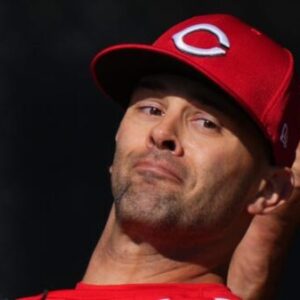Last time, I ran through a scenario where they Jays extend Vlad and Bo, try to patch the holes in the roster without making any long term commitments, and hope that growth from some young players can get them to the fringes of wildcard contention in 2025. Today, I’m going to look at what I consider to be the other viable course of action this season: going all in. The rules today are simple: we want to at least give the Yankees and Orioles a run for the division in 2025, and we’re willing to spend up to the first luxury tax surcharge threshold ($261m) to do it.

If you want a refresher, this post outlines the roster as it stands right now, and this one gives a quick overview of the team’s financial and trade capital. If the first surcharge is the ceiling, they have about $60m of room after arbitration, etc. , is dealt with.
I’m going to start off assuming that the extensions for Vlad and Bo that I outlined last time remain in place. That increases their combined salary by about $3. 7m over not extending them.
We could, if necessary, scrub the Bo extension and free up about $5m, but I think if this team’s making major commitments this winter they’ll probably also want stability on that front and be willing to pay a small price to get it. I’m also retaining my trade of George Springer and Leo Jimenez to the Giants. While it’s not a fun deal, I really just think it’s difficult to make this work while retaining Springer’s $24.
2m salary. Net of those three moves, the Jays have $74. 3m to spend.
One of the objections to the last piece was that people doubt Vlad signs for the 12/336 I mentioned when Juan Soto is going to get $500m+. That objection raises the issue of contract deferrals, which I’d hoped to avoid. As Soto factors into the plan, though, I don’t think I can.
Get in losers, we’re doing contract math. When players defer salary in MLB, for tax accounting purposes the deferred dollars apply in a discounted manner to the luxury tax calculation. As an example, Shohei Ohtani notionally makes $70m a year, but what he actually gets is $2m and an IOU for $68m in 10 years.
Another way of looking at it is that he makes ~$46m a year, immediately lends $44m back to the Dodgers at 4. 25% compound interest, and gets the principal and interest in a lump sum in year 11. That’s effectively how the luxury tax looks at his deal: 10 years and $460m with some financial engineering to make the top line number look bigger.
I would guess that’s basically how the Dodgers’ accountants see it too: yes they owe him $68m, but if they invest $44m now and earn reasonable interest they’ll have the money ready when they need it. Vlad’s deal could work the same way. I suggested paying him $28m a year for 12 years.
Alternatively, the Jays could pay him, say, $41. 67m a year for 12 years, but with $33. 67m each year deferred for 12 years.
It has the same $28m AAV for luxury tax purposes but gets him the headline of a $500m contract. I think this kind of thing is going to become more common. Superstars want massive numbers beside their name when they sign, and teams won’t mind because from an accounting POV it’s about the same for them.
All that preamble brings us to Plan A: sign Juan Soto to a 13 year, $650m contract ($50m a year), with $45m per year deferred for 13 years. In our luxury tax math, that pays him $30. 6m a season.
That may still not be enough to convince him to come, but the third largest contract in MLB history (after Ohtani and Mike Trout) is a legitimate offer. I’m also going to allow myself some breathing room: If Soto comes, I figure that they’re willing to bump payroll into the second threshold, say to $271m. The pursuit of Ohtani last year kind of implied that payroll can flex if it involves bringing in the kind of superstar who individually has an impact on revenue.
Soto isn’t on Ohtani’s level in that department, but he’s as close as anyone is, and I think Rogers would make some accommodations to be able to market a star of his magnitude. If it falls short, the Jays move on to outfield Plan B: Tyler O’Neill for 3 years and $48m. Less exciting!
The outfield options after Soto are much thinner, though. I don’t believe in Jurickson Profar, and anyway he should be a DH now. So, probably, should Anthony Santander, and he doesn’t look as good as his 2024 going forward.
A reunion with Teoscar Hernandez is appealing, but, again, DH, and I’m not sure his free swinging ways will age well. O’Neill gives you much of what the others do offensively, with a good eye and ample power, and he changed his approach in 2024 to the kind of all-in lift and pull approach that should keep making the most of his skills for a few more years. He’s lost a couple of steps, but he’s also youngest and the most credible defender of the group, projects to be the cheapest by a good margin, and doesn’t carry a qualifying offer.
I hate the idea of paying the QO penalty for players who are marginally worth it, especially when the Jays have a very good second round pick, so I can’t justify the cost of Hernandez over O’Neill. The other outfield spots, which I didn’t explicitly address last time, probably belong to Daulton Varsho and Nathan Lukes to start, with Alan Roden as a near-ready prospect with the offensive upside to come for Lukes’ job and Joey Loperfido filling in as 4th OF (and starting CF if Varsho isn’t ready for opening day). I don’t love leaving a job to prospects (or an MiLB veteran) like that, but I believe in Roden’s bat and there just isn’t enough money to have a sturdy veteran everywhere.
Spencer Horwitz can probably make it work in left to a degree as well if needed. Catcher: Same as last time: try to get Kyle Higashioka or Yasmani Grandal for ~$4m. Even in a go for it scenario, it’s hard to justify spending here when ‘pretty good’ is available cheap.
Infield: They don’t really need an infielder, but I think an upgrade always helps, and filling one spot enables some other moves. To that end, I suggest signing Ha-Seong Kim to a 5 year, $90m deal. Kim is an ace defender, someone who could either justify finally having an awkward conversation with Bo about third base or contend for a gold glove at third himself.
He’s the Jays’ favourite kind of hitter, avoiding strikeouts, taking lots of walks, and as a lead off guy presenting a real danger when he gets on the base paths. This moves Ernie Clement into a utility role, possibly also working as the short side of a second base platoon with Wagner and/or Horwitz. Trade: Speaking of enabling other moves.
Kim allows them to cash in some of their MLB-ready infield depth and consolidate. I suggest going back to a favourite Blue Jays technique: raiding the A’s. Toronto trades Orelvis Martinez, Addison Barger, Trey Yesavage, and Kendry Rojas to Sacramento (?
) for Brent Rooker and Michel Otañez. This works about the same as the Josh Donaldson and Matt Chapman deals: the Jays get multiple years of a current star who’s set to start making money (about $5m in his first go at arbitration in Rooker’s case), and the A’s get several guys who can contribute now for the minimum plus prospects. It’s a big price, but Rooker absolutely devastates the ball, and I believe his break out 2024 is real and largely repeatable.
Otañez is a gamble. His fastball is a monster, at 98mph with plus movement, and his slider is an effective weapon as well, but there’s risk that any command regression will make him too wild to trust. Still, it’s upside for the middle of the bullpen.
Starting Pitcher: Regardless of what happens in the outfield, they need a pitcher, and in this world they’re targeting an impact guy. There are aces available in Corbin Burnes, Blake Snell, and Max Fried, but it’s hard to fit a $30m salary and still address the other needs (i. e.
an entire bullpen). I think the Jays step back half a tier and sign Jack Flaherty for 4 years and $90m. They’ve shown a willingness to buy into breakout pitchers before (see Kevin Gausman), and Flaherty’s pinpoint command and feel for spin make him a strong candidate for the pitching lab.
He’s had some injury issues, but has also shown the ability to shoulder a starter’s workload, and with horses like Gausman, Bassitt and Berrios in the fold it makes sense to go after some upside. Bullpen: We still have 3 jobs to fill here, and only about $7-12m to do it (the former if Soto signed, the latter if it’s plan B). That means piecing together some value signings and trades.
First in the Soto scenario I would sign Danny Coulombe to a one year deal for $3m, with a $4m team option and a $500k buy-out. The southpaw missed some time in 2024 for surgery to remove bone chips from his elbow, just turned 35, and throws 91. All that lead the Orioles to decline a $4m option on him.
That said, he’s been excellent the past couple years and came back looking fine for a few appearances down the stretch. He’s very hard on lefties but isn’t a specialist, and he can spot three quality pitches in his cutter, slider, and curve. He has a 2.
82 ERA over the past four seasons. In the O’Neill scenario, with a bit more to spend, I’d offer the same one year, $7m deal with a $10m team option and $500k buy out I offered last time to A. J.
Minter. A hip injury derailed Minter’s 2024, but the three years before that he was as good as any left handed reliever in baseball, and I’d like to bet on a bounce back. Next, I’d take a shot at José Leclerc for one year and $4.
5m. The erstwhile Rangers’ closer saw his ERA jump to 4. 32 last year, but under the hood everything looks normal.
He still throws 95, the fastball, cutter and slider still all look dangerous, and his 31% K rate was actually his best in a couple of years. Now we’re truly out of money, so to round it out we need a significant trade. I wouldn’t part with one of the remaining top prospects (Ricky Tiedemann, Jake Bloss, or Arjun Nimmala) for a reliever, but a guy on the next tier like Charles McAdoo, Khal Stephen, or Jonatan Clase probably has to go out if we want an impact guy, and I think the state of the bullpen demands that kind of move if they’re going for it.
Three obvious targets, making the minimum on bad teams, are Washington’s Robert Garcia, San Francisco’s Ryan Walker, and Cincinnati’s Fernando Cruz. All three have big stuff, at least a one year track record of excellent MLB K:BB numbers, and project for ERAs in the low-mid 3s. For the sake of taking a stab, I’ll trade Charles McAdoo to Cincinnati for Fernando Cruz, but I think there are several plausible combinations here.
So that’s where it winds up. I had to gut the farm system, again, and set a record payroll to do it, but I think either version of the team above has an elite offense, a deep rotation, and a bullpen that should be able to hold a lead. The East projects as a monster, as usual, but I think that team has a shot to contend, and even if it falls short would be a scary wildcard opponent.
This post was originally published on this site be sure to check out more of their content.





